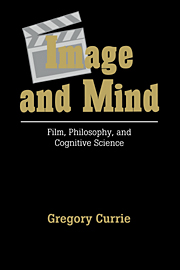Book contents
- Frontmatter
- Contents
- Preface
- Acknowledgements
- Film, 1895–1995
- Image and mind
- Introduction: the essence of cinema
- Part I Representation in film
- Chapter 1 The myth of illusion
- Chapter 2 The imprint of nature
- Chapter 3 Realism
- Chapter 4 Languages of art and languages of film
- Part II Imagination
- Part III Interpretation
- In conclusion
- Named propositions
- Bibliography
- Index
Chapter 2 - The imprint of nature
Published online by Cambridge University Press: 28 October 2009
- Frontmatter
- Contents
- Preface
- Acknowledgements
- Film, 1895–1995
- Image and mind
- Introduction: the essence of cinema
- Part I Representation in film
- Chapter 1 The myth of illusion
- Chapter 2 The imprint of nature
- Chapter 3 Realism
- Chapter 4 Languages of art and languages of film
- Part II Imagination
- Part III Interpretation
- In conclusion
- Named propositions
- Bibliography
- Index
Summary
A painting is a world; a photograph is of the world.
Stanley CavellThere are people who say that the photographic method gives the cinema the power not merely to represent the world, but to present it. Exactly what this means may not be clear; I shall try to make it clear. But note that this claim (I'll call it the Presentation Thesis) and the argument it has engendered predates the cinema, having arisen first in connection with still photography. I'll begin by considering the claim just for the case of still photography. Later, I shall ask whether the claim is more plausible when applied to the moving images of cinema. Most people who argue for the Presentation Thesis restrict their claim to photographic images which have not been subject to substantial manipulation after exposure. I shall follow them in this.
One source of confusion has to be cleared up right away. In the Introduction I pointed to the representational duality of film. When we ask what is represented onscreen, there are two possible kinds of answers: “Ingrid Bergman and Cary Grant acting on a set” or “two spies trying to foil a Nazi plot”. The claim that cinematography presents rather than represents the world must be understood as the claim that it presents the real world of actors, props, sets and locations, not the unreal world of fictional characters. If the thesis is right, film presents us with Ingrid Bergman and Cary Grant, not with the characters they play in the movie, for these characters do not exist.
- Type
- Chapter
- Information
- Image and MindFilm, Philosophy and Cognitive Science, pp. 48 - 78Publisher: Cambridge University PressPrint publication year: 1995



